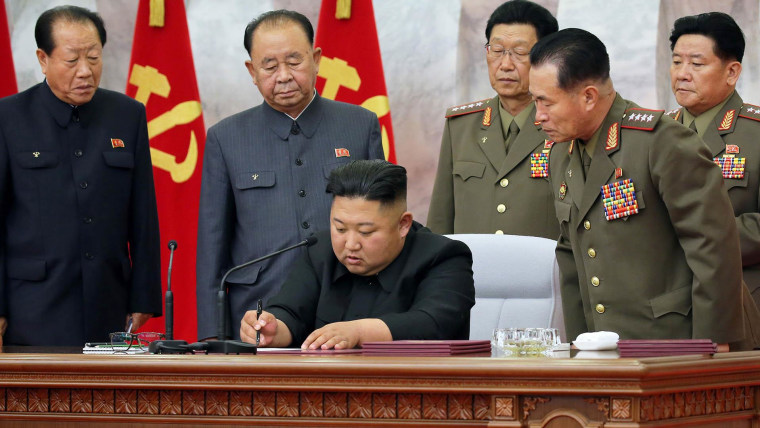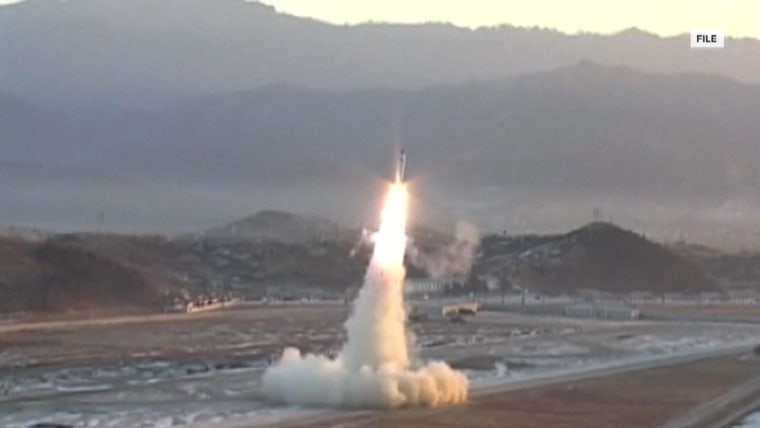WASHINGTON — North Korea officially declared an end Friday to its diplomatic dalliance with the U.S. But experts say it’s been clear for some time that President Donald Trump’s bold but risky effort to sweet talk Kim Jong into relinquishing his nuclear weapons never really went anywhere.
Two high-profile meetings with North Korea’s leader bought Trump a hiatus from bellicose rhetoric and nuclear tests, but Kim never stopped building nuclear warheads and the missiles to deliver them, U.S. intelligence officials and private analysts say.
Now, on the second anniversary of that first Trump-Kim summit in Singapore, North Korea is renouncing the diplomacy while promising to expand its weapons program, even as experts say it is ever closer to perfecting a long-range missile capable of reaching and destroying an American city.
Trump therefore joins a long list of presidents who tried and failed to cut a deal to get rid of North Korean nuclear weapons — but the first one who met face to face with the leader of the outlaw regime, lending it a measure of legitimacy. Trump at one point mused that he and Kim “fell in love,” and he showered praise on a dictator who is said by human rights groups to keep tens of thousands of political prisoners in vast gulags.
Trump made a series of other concessions, including the unilateral cancellation of joint U.S. and South Korean missile exercises. He got very little in return.
“In terms of the so-called goals of the summit, we made no progress in any of those things,” said Victor Cha, a former White House adviser to President George W. Bush and now senior adviser at the Center for Strategic and International Studies and an NBC News contributor. “And this was arguably the one piece of diplomacy into which Trump put all of his personal capital.”
If America benefited at all from the outreach, Cha said, “it probably prevented Trump from stumbling into a war with North Korea.”
Before the diplomacy, North Korea successfully tested a missile in September 2017 that experts said could deliver a nuclear warhead to the U.S. mainland. A few weeks later, Trump threatened North Korea with “fire and fury like the world has never seen.”
In March 2018, Kim sent Trump a message asking to meet, and Trump agreed.
What emerged from the Singapore summit was a vague agreement to work toward “complete denuclearization of the Korean Peninsula.” That phrase was not defined, and experts pointed out that the language was less explicit than a deal Kim’s father, Kim Jong-Il, agreed to in 2005 — and subsequently violated.
After the summit, Trump famously proclaimed on Twitter that Americans can “sleep well at night” knowing that North Korea was prepared to give up its nuclear weapons and that “there is no longer a Nuclear Threat from North Korea."
“None of that was true,” said Bruce Klingner, a former CIA analyst and North Korea watcher at the right-leaning Heritage Foundation. “And what we’ve seen since then from leaked intelligence assessments and commercial satellite imagery is that they’ve expanded and improved production facilities for fissile material, missile production, mobile re-entry vehicles and launch vehicles. And they’ve probably built eight or more additional nuclear weapons.”
The White House did not respond to a request for comment.
North Korea began souring on the negotiations last year after a second Kim-Trump summit in February ended without agreement and sanctions relief did not materialize. In December 2019, the North ominously promised a “Christmas gift” for the U.S. That threat did not appear to have been carried out, and earlier this year Kim disappeared from view for weeks amid speculation about his health.
Kim resurfaced last month, and on Friday, his government made clear that any agreement with Trump was now null and void.
“Even a slim ray of optimism for peace and prosperity on the Korean Peninsula has faded away into a dark nightmare,” the country’s foreign minister, Ri Son-Gwon, said in a statement marking the second anniversary of the Singapore summit.
He called the talks “nothing but a foolish trick hatched to keep [North Korea] bound to dialogue and use it in favor of the political situation and election in the U.S.,” adding, “Never again will we provide the U.S. chief executive with another package to be used for achievements without receiving any returns. Nothing is more hypocritical than an empty promise.”
North Korea’s strategic goal is “to build up a more reliable force to cope with the long-term military threats from the U.S.” Ri said.
Jeffrey Lewis, a nonproliferation expert at the Middlebury Institute of International Studies at Monterey, found the reference to the American election telling.
“They were never offering to disarm,” he said. “What they were offering to do was to give Trump good news stories for his political campaign, in exchange for sanctions relief.”
They didn’t get the sanctions relief, but what they did get was a friendlier Trump administration. The president stopped talking about North Korean human rights abuses. When House Republicans recommended sanctioning 12 Chinese banks allegedly involved in sanctions busting and money laundering for North Korea, Trump sanctioned none of them.
And the Trump administration cancelled joint military exercises on the Korean peninsula even as North Korean military exercises continued apace. Meanwhile, Trump pressed South Korea to pay more to support the U.S. troop presence on its soil.
“It didn’t improve relations with South Korea and it didn’t lead to any reciprocal actions by North Korea,” Klingner said.
China, Russia and South Korea also “took their foot off the pedal,” in terms of enforcing sanctions to pressure the regime, Cha said.
North Korea did send home the remains of 55 U.S. service members, but 619 sets of remains have been sent back in previous administrations, Klingner said.
The North freed five detainees, compared to 11 during the Obama administration. One of them was Otto Warmbier, who returned in a vegetative state and soon died.
Even the suspension of nuclear and long-range missile testing is less than meets the eye, Klingner said. “We’ve had several instances of three or more years of no testing under Bush and Obama,” he said.
It’s not that Trump wasn’t warned. Even as he was declaring victory, intelligence officials were telling NBC News that North Korea had not halted work on its nuclear program.
Even in public, intelligence chiefs acknowledged that North Korea was extremely unlikely to give up its weapons because it considers them necessary for regime survival.
That glaring contradiction was among the reasons Congress was unable to hold a public Worldwide Threats hearing, an annual briefing, this year. Intelligence officials didn’t want to have to once again dispute the president in public.
Still, some experts gave Trump credit for trying a different approach.
“I supported his outreach to Kim Jong Un in North Korea,” former CIA director and defense secretary Robert Gates, who served under both Bushes and Obama, told NPR Friday. “Everything else we've tried for the preceding quarter of a century had not worked.”
Cha agrees. But now that top-down summitry also failed, “I think it makes it harder for the next president, because the most important bargaining chip has already been played, and they have more weapons now so, they are less inclined to give them up.”
“Meeting with a U.S. president — it’s not that big a deal for them any more.”
Now that the deal has collapsed, Cha, Lewis, Klingner and other experts expect North Korea to do something provocative in the fall, in an effort to punish Trump during the political campaign.
“Perhaps an October surprise,” Klingner said.
World - Latest - Google News
June 13, 2020 at 05:19PM
https://ift.tt/2YrFNaC
From 'beautiful letters' to 'a dark nightmare': How Trump's North Korea gamble went bust - NBC News
World - Latest - Google News
https://ift.tt/2SeTG7d
https://ift.tt/35oCZy1
Bagikan Berita Ini
















0 Response to "From 'beautiful letters' to 'a dark nightmare': How Trump's North Korea gamble went bust - NBC News"
Post a Comment